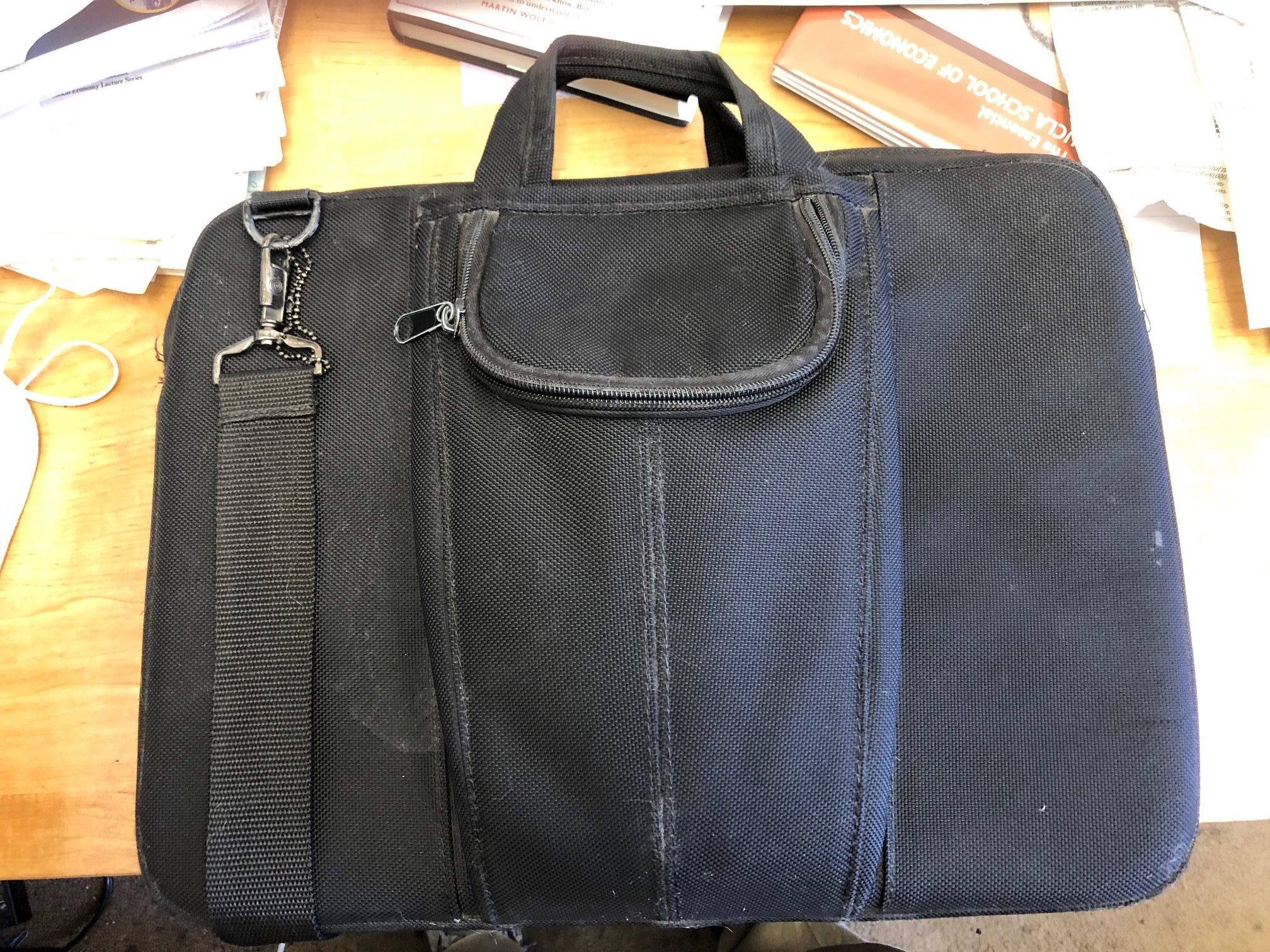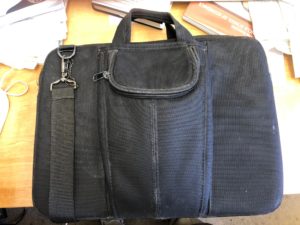

The picture above is of the computer case that I use to carry my Mac.
Why do I show it? To make a point about how making good economic decisions doesn’t always mean being cheap.
Looking back over the examples I gave to students, in about 40 years of teaching, of good economic decisions in my own life, I realize that a huge percent of them are of me saving money, being cheap, etc.
But sometimes making good economic decisions involves spending a lot of money.
I don’t remember what I spent on the above case. I think it was more than $40 and less than $70. The case was and is wonderful. It’s highly padded and tucked in tight, so that if you drop it about 3 or 4 feet, the computer is well protected. I did drop it a few times, with no bad consequences.
About 5 years ago, though, the zipper on it broke. I looked around on line and couldn’t find anything like that case. So I thought it might make sense to replace the zipper, which was plastic and clearly of lower quality than the case.
So I took the case to the shoe repair place near my office and asked them what it would cost to replace the zipper. The person told me that it would be expensive–about $40. What kind of zipper would I get? A metal zipper of much higher quality. Done.
Five years later, the case is still good. The most likely thing to go bad is–the zipper. If that happens again, I’ll have the same place, Federico’s Shoes in Monterey, apply their talents to replacing the zipper.

READER COMMENTS
MAP
Apr 10 2022 at 3:41pm
I used to be a road warrior and I had an incredibly durable suit back from L.L. Bean (this was a couple of decades ago, so I do not know if they make them the same way). I eventually had to throw it out because if I carried it using the shoulder strap, my tan raincoat would pick up the dirt the bag had acquired from airline check baggage, city taxis, etc. Almost as if I had rubbed the raincoat with newsprint.
Dylan
Apr 10 2022 at 4:57pm
This reminds me of one of my favorite Terry Pratchett quotes, which I will share in case you haven’t come across it before:
robc
Apr 11 2022 at 8:42am
Do we know how high the prevailing interest rates in Ankh-Morpork were?
I assume high and involved lots of risk to the borrower.
Dylan
Apr 11 2022 at 9:41am
You don’t have to worry about wet feet if you no longer have any.
David Henderson
Apr 11 2022 at 4:38pm
Thanks, Dylan.
I actually got a little lost in this. Who’s Sybil Ramkin and, more important, which option did Vimes choose?
Dylan
Apr 12 2022 at 8:06am
Sybil is the richest woman in the city. Vimes didn’t have an option, as Rob alludes to, there are not exactly well functioning credit markets in Ankh-Morpork, certainly not for someone of Vimes position. So he buys the $10 boots.
Grand Rapids Mike
Apr 11 2022 at 2:51pm
The story would make another nice anecdote in your book Making Great Decisions in Business and in Life.
David Henderson
Apr 11 2022 at 4:38pm
It would indeed. Thank you.
Thomas Strenge
Apr 12 2022 at 11:28am
My Dad has a great saying: It’s expensive to be poor. Spending money on quality can often save money over time, but only after a big initial outlay. Michelin tires are better than Ling Longs and save fuel and accidents. Germans still prefer building done houses and laugh at our wood construction.
Thomas Strenge
Apr 12 2022 at 11:32am
Stone houses
Daniel B
Apr 13 2022 at 1:30am
This reminds me of a lengthy quotation I encountered when skimming University Economics (someday I’ll have to read that massive text). I’ll post it here because I think it’s a brilliant passage (it can be found in chapter 7’s questions and answers section; the answer I’m quoting is found on pages 813-814). The question being answered is ‘“In the capitalistic system, only money or market values count in allocating productive resources.” Evaluate.’
David Henderson
Apr 13 2022 at 1:01pm
Nice quote. And the part about the neighbors buying land is so beautifully un-PC. I suspect that it applies just as much to most men today as it did back then. It’s just that many men wouldn’t admit it.
Evan
Apr 14 2022 at 11:23am
I responded to David’s post with a similar assessment, but now I see that I should have read this comment first. Much better at making similar points vs. my comment.
Matthias
Apr 14 2022 at 12:24am
I think something like this is why Germany’s hidden champions in their Mittelstand are often so economically successful:
The prototypical German Mittelstand company makes some obscure machine or part that some factory in China needs to keep running.
The factory in China might spit out low quality or high quality goods, doesn’t matter too much. But if that obscure part fails, the whole factory might grind to a stand still.
So it makes sense for the Chinese factory owner to eg pay the Germans ten times as much for something that’s twice as reliable as the competition. Because that’s still cheaper than the alternative of the Chinese factory shutting down completely while repairs are underway.
(Of course, this is all highly stylised. And there are obvious incentives for other people to get in on this highly lucrative niche that the German company in the example is in.)
Evan
Apr 14 2022 at 11:20am
One simple caveat that I would humbly submit for this object lesson: When one weighs the cost-benefit of repairing vs. replacing goods, get-what-you-pay-for quality, etc., one must be careful to count all of the costs.
For example, it’s possible that other parts of the bag are not actually good as new, but rather simply haven’t failed yet, such that the $40 to extend the life of the bag may not actually be buying you time equivalent to the life of a new zipper. Replacing parts on machines with moving parts, e.g. appliances, puts this concern in even sharper relief. It’s very often not worth it to replace 1 broken part in a microwave, for example, and less and less worth it as both the age of the microwave and the cost of the repair increase. If your microwave is 5 years old, for instance, and the repair costs 1/2 that of an equivalent new microwave, the repair would buy you a microwave full of 5 years parts with 1 new part. It’s usually just better to just replace it.
Along these lines: One must account for risk of catastrophic loss when weighing get-what-you-pay-for quality. E.g. If I misplace a pair of sunglasses, or if my small child dumps maple syrup all over my computer bag (both completely hypothetical of course, insert emoji here), the more expensive higher quality make that reduces the wear-and-tear is suddenly worth nothing. Buying cheap helps you hedge against that kind of risk.
Lastly, you have to account for the expenditure of time too. Repairs take both work time to run the errand (on drop off and pick up, usually) and calendar time (which means lost utility) as you wait for the repair shop to finish their work (assuming it’s not immediate service). Also it may take time to get estimates on the repair work in the first place. Clicking ‘checkout’ on Amazon to replace something, however, takes very little work time, and can take very little calendar time too (especially if you have Prime with the 1-2 day shipping).
I suppose the inverse is true too, though: When you consider get-what-you-pay-for quality, you should also really consider all of the benefits. E.g. If the cost-benefit analysis doesn’t justify the higher quality good on a pure cost-per-utility basis, you may still want to buy the higher quality good for reasons other than simple utility. Maybe you just think it looks nice. Or you are sentimentally attached to your old thing. etc. That’s fine too. That’s worth something, and it’s good to recognize that value.
It’s just important to really be honest with oneself when considering these kinds of decisions – to really capture all of the costs and all of the benefits, so that you know what you’re paying for and why.
Comments are closed.